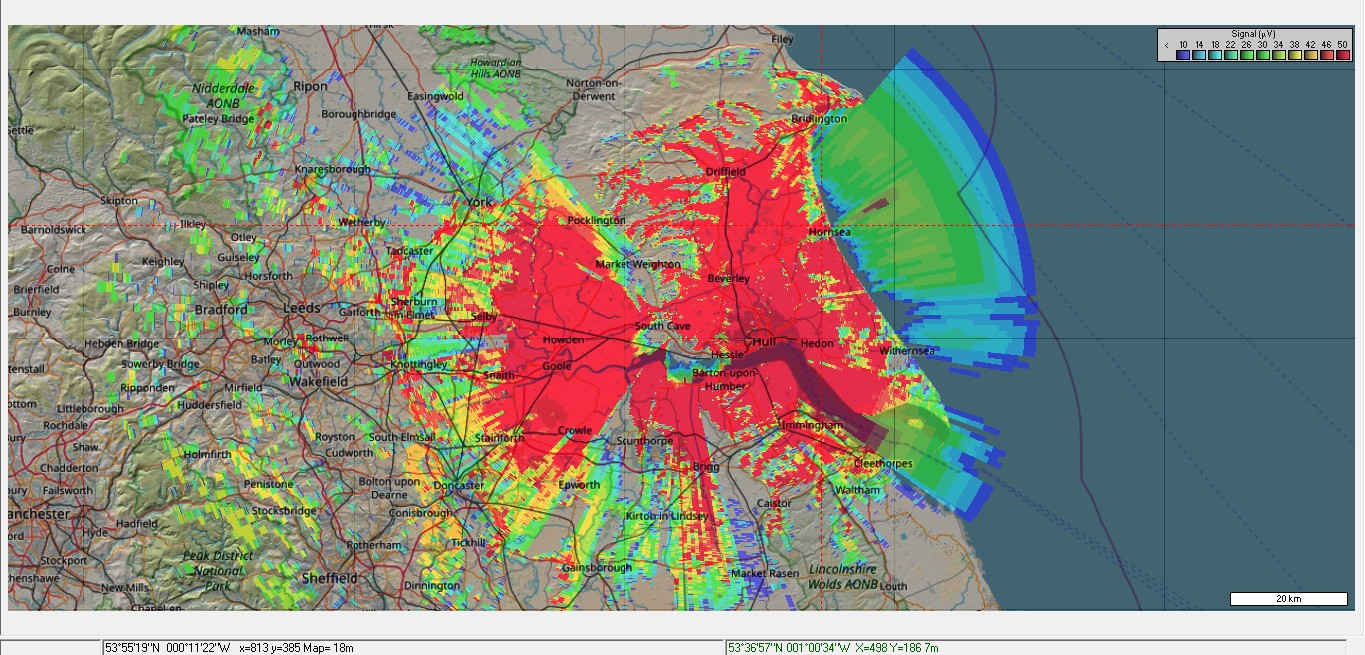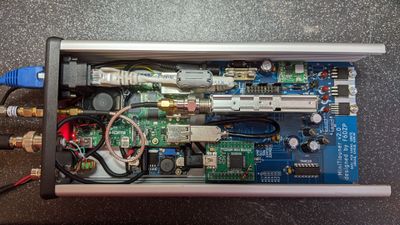GB3EY
UPDATE: GB3EY now operational EY repeated its first digital pictures on the 22nd November 2020. Please send reports of reception to clive AT hesh.co.uk
Output: 1308MHz, DVB-S, QPSK, 1000kS/s, MPEG/H262, FEC 3/4, Left channel audio only.
Input: 1275MHz, DVB-S QPSK or DVB-S2 QPSK or DVB-S2 8PSK, 333 or 1000kS/s, H262 or H264 or H265, any valid FEC, Left and Right audio channels strapped together.
Note that GB3EY is switched off between midnight and 11am every day to save electricity.
A new NoV was issued for GB3EY in August 2018 allowing the move to the East Yorkshire Repeater Group's site at Cave Wold Radio Station near South Cave in East Yorkshire. The QTH locator is IO93RS37ME. The new site is 155m ASL with a good take off in most directions. The predicted coverage was created using Radiomobile and assumes 10m mast with a 15dBi antenna at the receiving end. This will be a substantial improvement over the old site on the North Sea coast at Aldbrough.
The repeater is returning using digital ATV to reduce the bandwidth occupied. The parameters are currently 1MS/s, FEC 3/4, with MPEG-2 encoding on 1308MHz. Test transmissions were run from a temporary mast from August to October 2019 until the main tower was renovated and a single Alford Slot antenna was installed at 25m AGL fed with 33m of Andrews LDF5-50A. The Alford was made by G3GJA and uses a coaxial 4:1 balun formed from RG402 semi-rigid. This was found to be much easier to construct and test than the usual slotted sides coax balun approach.

A work party at the EYRG site checking the P80 tower with 5m extension. A further 3m extension has been added for the Alford Slot
A temporary breadboard (actually plywood!) transmitter comprising of a BATC DTX1, a G4DDK PGA103+ pre-drive, a G4BAO driver and a G8EQZ built M57762 Mitsubishi bipolar brick PA producing 4.8w RMS has been running test transmissions since then. So far it has been received at 79km from the repeater which is very good for 11w ERP. A video source derived from a first generation Raspberry Pi provides a slideshow of testcards and photos of East Yorkshire. No inputs are available at this time.
Progress to date is good; the logic from the analogue repeater has been renovated and updated by Bill G3RMX, a Comag receiver has been found and the transmitter, comprising of two modules funded by G4YTV and made by Bert PE1RKI have been tested and mounted on the RF deck along with two SMPS for 12v and 28v rails . The original G3JVL filter has been retuned and a new duplex filter has been tested but it flashed over at the 20w power level. A solution using Teflon tubing will be tried to correct the problem. Isolation between the TX and Rx ports of the duplexer at 1308MHz is 75dB which might just be enough without further filtering from the JVL filter for single antenna working.
In the longer term, a dual band beam for 2m and 70cm will be installed with a Minitioune for inputs on those bands in the future with 333kS/s or similar RBDATV signals. G4YTV has funded a HamKits video switcher that will be used to build a new logic around a Raspberry Pi. We hope to resurrect GB3XY the 10GHz ATV repeater, that was operational from the same site, as a DATV repeater linked to GB3EY. However, designs for upconverters for 3cm are not readily available.
The site is exclusively used by the East Yorkshire Repeater Group and is a former Pye Telecoms location. It also hosts GB3HS a 2m triple mode repeater, GB7HU a 70cm D-Star repeater and a Raynet repeater that can be configured for cross-band 2m / 70cm or in-band 70cm operation.
UPDATE: GB3EY operational EY repeated its first digital pictures on the 22nd November 2020. Please send reports of reception to clive AT hesh.co.uk.
Following a long period of development, during which the beacon mode was disabled, improvements were made to the following:
1. A replacement was sought for the Comag set-top box to give 1MS/s and H264. Several were tried and one looked promising as with two they could be made to switch between 1 and 2MS/s but they would lock up and give no video despite showing a locked status. Eventually, a headless version of the BATC Ryde was built to give 333kS/s and 1MS/s, DVBS and DVB-S2, H262,H264 and H265. This was funded by the BATC Bursary scheme.
2. The JVL filter was too big to fit in a cabinet and it didn't provide any protection against the Claxby Radar on 1254.5MHz. A bandpass filter with two notches (1254.5 and 1308MHz) was obtained from Germany and the duplex filter tuning improved by replacing the 0.5mm air dielectric with Teflon tubing over the resonators
3. The DTX1 modulator only works with broadcast standard syncs. The BATC I2C based logic used on the analogue GB3EY does not use interlacing so a new SPG was built around the ZNA134 (CAT18 goody bag) and the I2C genlock chip was added and new syncs fed to it. The RGB feed from the I2C boards was then fed with the ZNA134 syncs to a new PAL encoder using the AD724. This gives a much improved, broadcast quality video output.
4. The logic was modified to accept a digital locked status from the receiver to replace the 15.625kHz line frequency detector that was used for a signal on the input flag.
5. A fault in the video switcher (MAX444) was traced to an IC socket pin not pushed through the PCB
6. The switched mode power supplies were found to be noisy and the 5v output failed twice for no apparent reason. That and the -12v SMPS were replaced with high efficiency modules and Pi filters placed on the inputs and outputs.
7. Logic cooling was improved with a larger fan.
8. The duplexer repeatedly flashed over, so a new duplexer was bought from ID-Elecktronik to go with the receiver filter from them. A 13dB gain pre-amp was placed between the duplexer and the Rx bandpass filter.
9. Fans were added to the PSUs to improve cooling and a baffle was fitted around the main PA fan intake to stop air being recirculated.
10. A Portsdown streamer has been installed. Video and audio is sampled from the Tx feed and then sent to the BATC Streamer here: http://batc.org.uk/live/gb3ey

